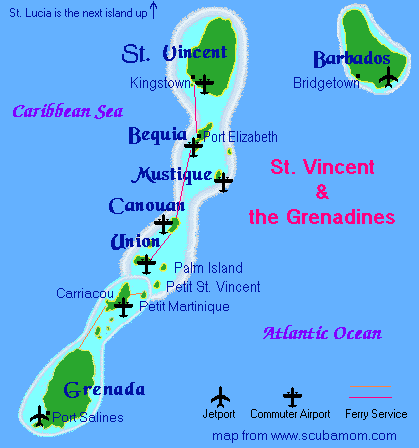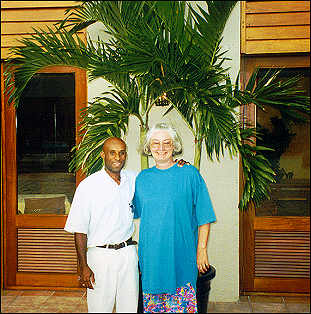|
|
|
You know the old saying... "Paradise isn't easy to reach, but it's worth it." That applies to St. Vincent and the Grenadines, although it's much easier today than back when only occasional supply ships traveled between the islands along with a few yachtsmen sailing their own boats into "uncharted waters"! Nowadays, a sailboat launched from St. Lucia or Grenada (which both have yacht charters, jetports and international airline service) is the "easiest" way to visit the islands in the Grenadines. If you only plan to vacation in one or two islands,
then your best bet is to fly into Barbados or Grenada and hop over to the
Grenadines via commuter airlines.
 Between Barbados and St. Vincent, three Caribbean commuters provide scheduled daily service - BWIA, Caribbean Star (Baker), and LIAT - a 50 minute flight. Within the Grenadines: Mustique Airways , TIA, and SVG provide shared and private charters. Visit their websites by taking the underlined links above and contact them for more information. Island hops take anything from 5 minute flights between adjoining islands to 20 minute rides from St. Vincent to Union. SVG also provides service from Grenada. Or ... you can take a ferry between the islands, most are based out of St. Vincent. There's also ferry service from Grenada to Carriacou. Russ Filman's website has a good ferry schedule for St. Vincent to Bequia (note the limited weekend service!) The trip takes about 1 hour. MV BARACUDA goes between St. Vincent and Union three times a week with stops at Bequia, Canouan, and Mayreau - a long 5 hour and 15 minute trip, but the plus is that you'll get to see all the islands along the way! (note, the link above is from Scuba SVG's super website). It might also be possible to have a day-trip sailboat transfer you between islands, or a local hired boat. A friend of ours who needed to go from Bequia to Mustique went down to the docks of Fort Elizabeth in Bequia, found a big "cigar" boat and hired it to give him a fast ferry ride to Mustique! Creative thinking is a good idea in the Grenadines! But... even the best laid plans can change! Our trip in 1999 included Bequia, an island we missed seeing the year before. The plan was to fly into Barbados and overnight at the lovely Coral Reef Hotel, then take Mustique Airways to Mustique for a two night stay at Cotton House resort, transfer to Bequia, hop down to Union for 4 nights at PSV, then fly to St. Vincent and Young Island resort – 14 days in Paradise. The problem with an itinerary like this is figuring out how to transfer from island to island – the choices are boat, ferries, and/or air charters. Of course, the BEST way to see the Grenadines is by sailboat, but I'm subject to mal de mer (sea sickness), so that was not an option for us. Mustique Airways has scheduled flights from Barbados to the various Grenadine islands each weekday afternoon and charters on weekends. It also has a few scheduled hops between St. Vincent and Union and at additional cost can drop off or pick up at the islands in between. TIA and SVG airlines also offer charters, so there’s quite a few flight options for those who want to quickly hop from island to island. Several ferries have daily service between St. Vincent and Bequia, plus the “mail boat” runs twice a week with stops at most islands between St. Vincent and Union. Our original plan was to take the scheduled late afternoon flight from Mustique to St. Vincent (a very good deal at $50 which must be arranged by Cotton House resort), and then catch the evening ferry from St. Vincent to Bequia which takes about an hour at sea. Since I'm prone to mal de mer, we decided to charter a $290 five minute direct flight from Mustique to Bequia. My husband was a little disappointed since he loves boat rides and thought the ferry would be an adventure. But the flight/ferry plan would have taken us 4 hours to transfer! After a few days visiting Bequia, we arranged a "flagstop" pick up by Mustique Airways at Bequia to fly us on to Union to meet our boat ride to Petit St. Vincent. The final "version" of island transfers was costly in terms of airline add-ons, but a gained us more beach time! The bottom line is to have a plan and reservations,
but be prepared to change schedules and modes of transportation if needed.
|
|
It depends on where you are staying, but everything for a week long vacation should easily fit in 2 carry-on bags per person - 1 suitcase for the overhead bin and 1 soft duffle or backpack that can fit under your airplane seat. If you have chartered a yacht, then pack only duffles or soft-side luggage since hard-side luggage won't fit in the nooks and crannies of a sailboat. Why not use large suitcases and check them? Well, you can, but luggage doesn't always arrive in the islands when you do! If you must check some luggage, then BE SURE to carry on at least one suitcase with enough to get you by a day or two - toiletry articles, swimsuit & T-shirt for the day, and a set of clothes for dinner. I've seen far too many vacationers arrive who checked all their luggage and had nothing to wear except the clothes on their backs for the first day or two! Most of the places to stay or dine fall into one of two categories: * casual resorts, hotels, and restaurants
* upscale resorts or restaurants with a dress code, such as Cotton
House, Young Island, and Petit St. Vincent (PSV):
In the evening, "resort wear" or "smart casual" attire is usually worn:
ladies wear sun dresses, long pants & tops; men wear slacks, such as
dockers, and collared sport shirts. Very few resorts require coat
and tie in the warm tropics anymore. You might "get away" with really
nice tropical shorts and a golf shirt at these resorts if you have an aversion
to slacks in the islands.
 Generally, we stay at resorts with a dress code, so... We both wear long pants and shirts plus our "dinner shoes" on the plane going down. In one suit case, I pack 1 pair of slacks plus 3 nice shirts for Kenny which he can wear for dinner during our stay (plus the ones he's wearing on the plane). If anything gets spotted, I'll wash it. Add three bathing suits and/or shorts and three T-shirts, a pair of beach or watersports shoes, underwear, and socks. If his snorkel and mask don't fit in the suitcase, then they will go in the small soft carry-on along with his shaving kit. For me, I pack almost the same thing plus a small hairdryer if the accommodations do not provide one. We always take a couple small bottles of shampoo too. If you are staying at a place with no dress code, then substitute nice pairs of shorts and T-shirts for the dresses, pants, and collared shirts. Throw in a small can of bug spray - we seldom see bugs in the islands, but it's handy to have just in case. During the winter months, evenings can be cool if a breeze is blowing, so you might want to pack (or wear on the airplane) a very lightweight jacket or long sleeve shirt. I always take an empty, medium sized soft duffle bag (rolled up and stuffed in the side of a suitcase) in the event we purchase lots of "stuff" in the islands, like gift T-shirts and trinkets for the family. For our return home, our dirty clothes go into the duffle to be checked on the airlines, and the new things go into the suitcases. Oh, I almost forgot to mention that in our 4 carryons, we also put quite a bit of camera gear, film, and the laptop too! NOTE: IF you check luggage on your way to the islands, put a large mailing label on the side of each suitcase or tape around duffle bag handles and include the following information: 1. Your name, date
of flight, and flight numbers.
IF your luggage doesn't make all the connections that you do, airline
employees will be able to read the tags and quickly route it along its
way. We've never have a lost or delayed bag when we do this.
|
|
Absolutely delightful, of course! Constant trade winds provide a pleasant year around climate. Land and water temperature in the evenings can vary from 77 degrees in January/February to 86 degrees in August/September. Highs vary from mid 80s in the winter months to low 90s in the summer. The "dry season" is generally December to May with most short tropical showers occurring during the hurricane season from mid-July to mid-November. Diving and snorkeling visibility averages 100', but can drop to 60' in the warm summer months, or reach almost 200' in the winter and spring months. You can click the image below for current weather.
 |
|
Obviously, the winter months (from the week before Christmas to Easter) are the busiest season since many vacationers and yachtsmen are escaping cold weather to enjoy warm Caribbean temperatures. The accommodation rates are highest during this time too - don't head for the islands without a reservation somewhere! In the off season (after Easter until mid December), hotels usually have vacancies and rates are about 1/3 less than the winter season. However, it is still best to have hotel reservations before you arrive. Hurricane Season is from mid-summer to early November, but the most active storm months are generally August and September. Many people go during that time, but should be prepared to quickly leave the islands if a hurricane threatens. Generally, St. Vincent & the Grenadines are "south" of the hurricane
belt, so the chances are less that a storm will hit them than the upper
islands such as the Virgins, Anguilla, and St. Martin.
|
|
Most hotels and restaurants take major credit cards, but it is handy
to have some small U.S. bills ($1, $5, $10, and $20s) for ferries, taxis,
and out of the way places to eat or drink. We usually take our credit
cards and about $300 - Kenny carries half; I carry the other half.
Some resorts accept personal checks, so we take a few of those too.
|
|
The same as at home - 10 or 15% depending on service. However, some resorts and restaurants automatically add a service charge to their rates. In this case, you have no obligation to tip extra. Some people do tip individual staff members who do something extra, or sports instructors. If you scuba dive, it's always appropriate to tip the divemasters.
|
|
One of the best ways to see the islands is to either hire a driver for
a few hours or the day, or rent a car and drive yourself. Generally,
rental cars are over $40 a day (rather expensive) and you must also purchase
a "driving permit", but you have the freedom to wander wherever you want
to go to see and hike, snorkel, or explore without the limitations of a
"tour". On St. Vincent, I highly recommend you hire a driver
- roads aren't really marked and it's a big island.
This is just opposite of driving in the U.S. and takes a little getting used to. The first time we ever drove in a British island, my hubby pulled out on the road and was fiddling around with the windshield wipers. As expected, he was on the right/wrong side of the road and I looked up and saw a huge dump truck coming right at us! Fortunately, the rental car had a big sign plastered to the dash that said "DRIVE LEFT" and I blurted out "GO LEFT!". After that little incident, he stayed on the left side of the road. Traffic is not too heavy in the smaller islands, so it's a good place
to learn to drive "opposite" if you are from the states or a country that
drives "right". However, you'll find lots of hair-pin turns, roller-coaster
roads, and steep mountains. When on steep inclines, downshift - use
the same gear going up as well as going down... don't ride your brakes
going down steep inclines, use lower gear and let the engine do the work
of slowing down.
|
|
If you plan to do a lot of snorkeling, then you should purchase a snorkel and mask at home before you leave on your trip rather than renting them in the islands. Some resorts furnish them, however, it's always best to have your own. Masks and faces come in all shapes and sizes so the secret to good snorkeling is to have a mask that fits your face perfectly! And please don't buy one of the cheapo snorkeling kits! Go to a dive shop and have them help you find a mask that fits. Which kind of snorkel is best? Any brand will do, however, I like the kind that keep the water from washing down the top if we hit a wave. Hubby uses a plain, cheap snorkel and is perfectly happy. Fins (flippers) are a matter of individual preference. My husband doesn't use fins to snorkel; I do. If you are staying at a resort that furnishes fins, then to save weight and space in your suitcase, use the resort ones. However, you might want to buy some "fin socks" at a dive shop that will keep fins from rubbing your feet the wrong way. I prefer fins with back straps that must be worn with scuba booties. Couple of reasons that this is a good idea... the booties will fit your foot, and also provide excellent protection from sharp coral or shell when walking out in the water to start snorkeling. My fins are the shortest ones I could find so that they will fit in my duffle carry-on bag. |
|
Proof of Citizenship should be valid passport only |
|
Alas, detailed travel books about St. Vincent and the Grenadines are far and few between. Fortunately, CRUISING GUIDE PUBLICATIONS, a Florida mail order bookstore, offers a very detailed guide to St. Vincent & the Grenadines in their "Sailors Guide to the Windward Islands". Don't worry if you aren't planning to cruise in a sailboat, the information is excellent for landlubbers as well. Want to know the best way to reach the islands, or the phone numbers of rentals and resorts, where to eat, shop, snorkel, dive, fish, or sail? Most everything you want or need to know is in this Cruising Guide publication. They also publish books on other Caribbean islands too. Take this link for ordering information: Cruising
Guide Publications
|
|
I am a firm believer in using a good travel agent who specializes in the Caribbean! He can coordinate our flights with the resort destination, trouble shoot any airline schedule changes (and American Airlines constantly changes schedules), and be sure the resort has the dates available that we want. He does the entire trip, all the reservations including hotel bookings. Here's our Travel Agent (for the last 20 years!)
Olson Travel & Nautical Charters 726 Oriole Street, Corpus Christi Texas 78418 Phone: 361 937-1733 Fax: 361 937-2726 Toll free: 800 525-8090 Visit his website at Olson
Travel & Nautical Charters
|
|
Enjoy your vacation in the islands! |
|
|
 |